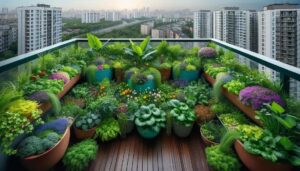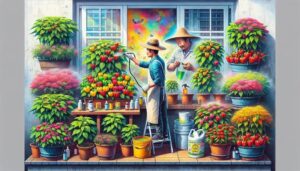An RV container garden allows for the cultivation of fresh produce in limited spaces by using lightweight containers, selecting compact plant varieties, and employing strategic sunlight and water management techniques.
Ever thought about growing your own fresh veggies while traveling? With an **RV container garden**, it’s not just a dream. This compact setup lets you cultivate a mini garden on the go. Discover how to choose the right plants and containers to make it all work, and keep those veggies thriving no matter where the road takes you.
choosing the right containers for your garden
Selecting the right containers for your RV garden is crucial to ensure your plants thrive. Consider the material of the containers first—options like plastic, ceramic, and metal each have their pros and cons.
Plastic is lightweight and durable, making it a popular choice for mobile setups. However, it can heat up quickly in the sun. Ceramic pots, on the other hand, offer better insulation for plant roots but can be heavier to move. Metal containers provide a sleek look but may lead to overheating if exposed to direct sunlight for too long.
Next, focus on size and depth. The size of your container will determine what plants you can grow, and deeper containers are necessary for root vegetables. Make sure your containers have adequate drainage holes to prevent root rot. Line the bottom with gravel or broken pottery to help with water flow.
Consider using self-watering pots for less maintenance, especially handy during long travels. A self-watering system helps regulate plant hydration, which is a valuable feature for an RV garden.
Choosing the right containers involves balancing weight, material, size, and function, matching them to your gardening goals and travel needs.
best plants for small-space gardening
When it comes to small-space gardening, choosing the right plants is essential to maximize your yield and maintain a lush garden. Start by opting for compact varieties that thrive in containers. Herbs like basil, rosemary, and thyme are perfect as they grow well in confined spaces and add fresh flavors to your dishes.
Consider leafy greens such as spinach and lettuce, which regularly provide harvests without taking up too much room. For those interested in more substantial yields, dwarf vegetable varieties like cherry tomatoes, baby carrots, and miniature peppers are excellent choices.
Succulent plants and certain flowers such as marigolds can be interspersed among your vegetables, offering not only beauty but also contributing to pest control. Additionally, climbing plants like peas and beans make good use of vertical space by growing upwards rather than spreading out.
Choosing the best plants for small-space gardening involves a mix of culinary herbs, compact vegetables, and ornamental options to create a functional and aesthetically pleasing gardening area.
soil and nutrient tips for container success
Achieving successful container gardening depends greatly on using the right soil and nutrients. Opt for a lightweight potting mix rather than garden soil which can become compacted in containers. A quality potting mix provides the necessary drainage and aeration for root health.
Adding organic matter such as compost or aged manure enriches the soil, boosting its nutrient content and moisture retention abilities. This enrichment helps maintain a steady supply of nutrients for plants.
Consider adding slow-release fertilizers designed for container plants to provide consistent nourishment. These fertilizers release nutrients over time, which helps avoid fluctuations that could stress plants.
Periodically check soil moisture levels. While most container gardens require regular watering, you must avoid overwatering which can wash away nutrients and cause root rot. Using a moisture meter can help ensure that the soil stays at the optimum moisture level for plant growth.
Understanding the specific nutrient needs of your chosen plants is also essential. Some plants might require additional supplements like calcium or magnesium for optimal growth. Regularly assess plant health for any signs of deficiencies such as yellowing leaves or stunted growth to adjust nutrient inputs effectively.
watering strategies for RV gardens
Effective watering strategies are key to the success of any RV garden. Consistency is important; plants thrive with a regular watering schedule. Use a watering can with a narrow spout for better control in confined spaces.
To avoid overwatering, ensure that containers have adequate drainage holes. This prevents root rot and helps maintain plant health. Consider using self-watering pots that maintain moisture levels with minimal effort.
Check the soil moisture frequently. In an RV setting, conditions can change rapidly, affecting water needs. Use your fingers or a moisture meter to test the soil. Adjust your watering based on the plant’s requirements and environmental factors like sunlight and temperature.
During hotter periods, increase watering frequency as pots dry out faster. Conversely, reduce watering in cooler, shaded locations. Augment your strategy with mulch, which retains moisture and reduces evaporation.
Monitor plant health regularly for signs of dehydration, such as wilting or yellowing leaves, to adjust watering as necessary. Gathering knowledge about each plant’s specific needs allows you to maintain optimum hydration effortlessly.
sunlight and placement considerations
Proper attention to sunlight and placement is vital for a flourishing RV container garden. Assess the light needs of your plants. Most vegetables and herbs require at least six hours of direct sunlight daily. Position your containers to maximize exposure.
If full sun isn’t available, choose plants that tolerate shade or partial sunlight, like lettuce or spinach. Use reflective surfaces to increase light exposure if needed.
Regularly rotating pots can help your plants grow evenly by exposing all sides to the same light. If a spot becomes too hot, consider adding a shade cloth or moving pots temporarily.
Take advantage of vertical space. This method allows for placement on shelves or hanging baskets, which keeps them out of a crowded floor area and ensures they receive ample sunlight.
Lastly, be mindful of wind exposure. Wind can dry out soil and damage plants. Position containers where they can avoid strong gusts or provide a barrier like a mesh screen for protection.
troubleshooting common garden issues
Even with the best care, common garden issues can arise. Recognizing and addressing these problems quickly helps maintain a healthy garden. Pest infestations are frequent, with bugs like aphids or caterpillars causing damage. Inspect leaves regularly and remove pests by hand or use natural repellents such as neem oil.
Yellowing leaves could indicate nutrient deficiencies or overwatering. Assess the soil moisture and adjust your watering schedule. Supplement with fertilizers if a nutrient imbalance is suspected. Leaf spot diseases can occur due to fungi or bacteria, often signaled by discolored areas. Improve air circulation by spacing plants properly and prune affected leaves.
Watch for wilting signs, which often suggest underwatering or root issues. Check drainage to ensure soil isn’t waterlogged, and adjust watering practices. If plants are growing poorly, consider the light conditions. Ensure they receive the required sunlight and relocate if necessary.
Keep track of these issues to gain a deeper understanding of your garden’s health. A vigilant approach coupled with timely interventions keeps your RV garden thriving.
Bringing Your RV Container Garden to Life
Creating a thriving RV container garden can be an incredibly rewarding experience. By selecting the right plants, ensuring proper soil nutrition, and paying attention to watering needs, you set a strong foundation for growth.
Mindful placement for sunlight and addressing common issues quickly will keep your garden flourishing. Engaging with these strategies not only enhances your gardening skills but also brings fresh produce and vibrant greenery into your RV lifestyle.
Keep experimenting, be aware of your plants’ needs, and adapt your approaches as needed. With time and care, your RV garden will not only survive but thrive, offering a slice of nature wherever your travels take you.
FAQ – Frequently Asked Questions about RV Container Gardening
What are the best types of containers for RV gardening?
Lightweight and durable containers like plastic or self-watering pots are ideal for RV gardening due to their easy portability and moisture control.
Which plants thrive best in small-space gardens?
Herbs like basil and rosemary, along with leafy greens such as spinach and lettuce, are excellent choices for small-space gardens.
How often should I water my RV garden?
Watering frequency depends on the plant types and environmental conditions. Generally, checking soil moisture regularly will help you adjust the watering schedule appropriately.
How can I maximize sunlight for my RV garden?
Position your garden where it can receive at least six hours of direct sunlight, use reflective surfaces, and rotate pots to ensure even light exposure.
What can I do to prevent pest issues in my garden?
Regularly inspect your plants for pests and remove them by hand. Using natural repellents like neem oil can also help manage pest problems.
How do I maintain healthy soil in my container garden?
Use a quality potting mix with organic matter and apply slow-release fertilizers. This practice ensures nutrient-rich soil and encourages healthy plant growth.



